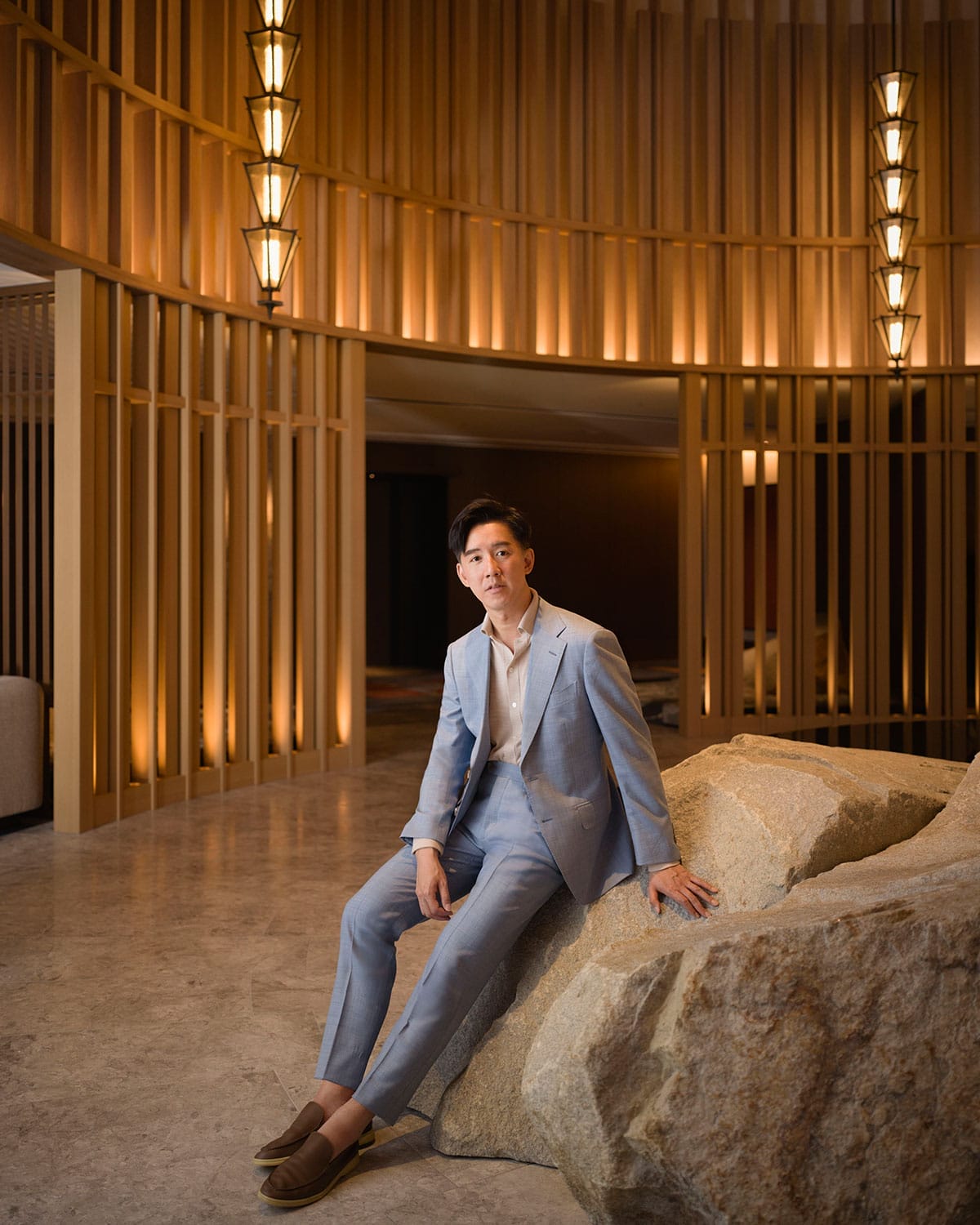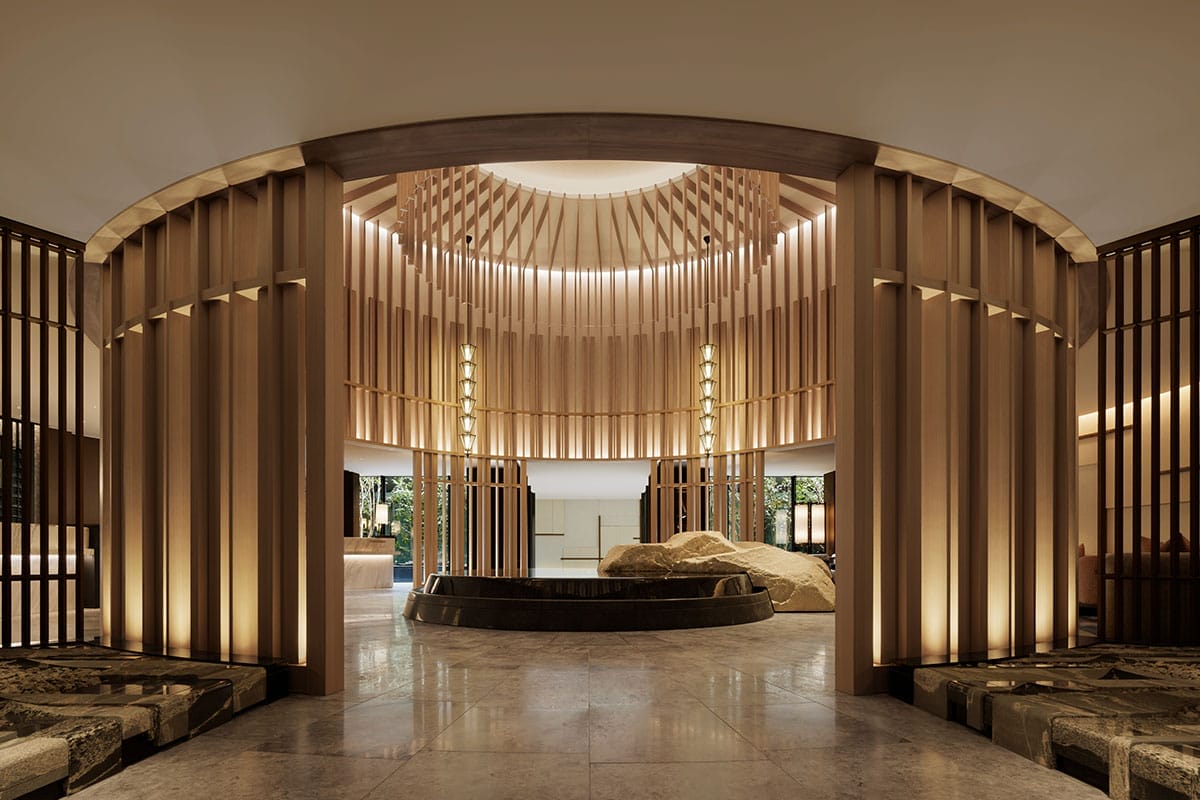All throughout history, we quote legendary names to describe apogees of achievement and exemplars of excellence. Albert Einstein. Leonardo da Vinci. Michael Jordan. You don’t need to be a fan of each field or a student of their specialisation to understand how extraordinary they were and are. Their names go beyond being brands—they become benchmarks. So it has become with André Fu, the interior architect who has designed many of the world’s most beloved luxury hotels, residences, restaurants, galleries, stores, and more. Ever since he put his name on the map with The Upper House in 2009, Fu has become one of the most sought-after designers and the name everybody wants to include in their property’s introductory notes.
Yet, despite his laundry list of awards and acclaim from all over the world, Fu is an unassuming fellow. I recently met him during the launch festivities of the Waldorf Astoria Osaka, which he designed quite majestically, and he greeted me warmly in the hotel’s picture-perfect Peacock Alley. I’ve met people with a tenth of his portfolio and plaudits, but with 10 times the ego and entourage, yet Fu (without a single minder) seemed almost embarrassed that someone wanted to pick his brain on hospitality, creativity, and what it took—and takes—to ascend to the upper echelons of luxury design.
Here, an abridged conversation with Fu on stardom, joy, the power of design, the evolution of luxury, and legacy.

Everybody knows André Fu, the internationally acclaimed, award-winning interior architect. But what was André like before all that?
I still feel that my curiosity in the realms of design and hospitality remains the same. Going from a teenager who was interested in the realms of hotels and design to now being able to create these experiences—turning from an outsider to somewhat of an insider—that process has been rewarding.
Was there a moment when it dawned on you that you became the André Fu?
All of the recognition is to be valued, but to me, the real joy in what I do is when I feel that whatever I’m entrusted to create has a window to connect with people. I still get a thrill walking into construction sites. It’s hot and humid, I’m in a safety hat, and there’s nothing glamorous at all. But you see thousands of workers who are all there to realise an idea I had.
That’s why I still try to give as much as I can to my projects even until today. It’s easy to have great ideas, but it’s not a given that these ideas can be realised. So, I’ll try my best to motivate the people around me, to ensure that stories are told the right way, images capture the perfect moment, and designs are refined to a level that is pragmatic but can be appreciated.

You’re known for combining European principles of beauty with Asian qualities and traditions. How do you achieve this balance?
It all boils down to my upbringing, which was rooted in Asian culture, but it was also heavily influenced by European culture at the same time. I live in a world that navigates in between. In my professional life, I could be dealing with Taipei, London, Bangkok, Los Angeles, all within a period of hours. I never need to switch off my European button or my Asian button per se. I guess it’s all very organic.
You once said that “your design philosophy is about provoking new ways of thinking about what luxury means”. What are these new ways in 2025?
Perhaps that’s kind of an overstatement. I’d say that it’s just being authentic. At the end of the day, what is hospitality? It’s about creating a backdrop for people to have an engaging and comfortable time. There is the spectacle and there are the curated moments, but ultimately it’s just to relax and enjoy. Those are the core values of my philosophy.

You’ve also said, “true luxury is in the experience and not just the aesthetics”. How has your experience in luxury evolved over time?
The world of luxury has evolved tremendously, especially in the hospitality field. When I first started out, the focus was more on the spectacle. For example, when you thought of a presidential suite, it was always the grand piano, the double-height room with the curtains. That was the era then. Luxury was very formal. Today, it’s about being comfortable and being yourself. Social media has educated people very well about new experiences and how where you stay is a reflection of you.
But what hasn’t changed is my belief in creating, in the soul—to create experiences that have a soul to them. It’s not just about the spectacle; it’s about going into a place where you feel that the design is intimate and created around you.
André Fu Living launched in 2016. Has it achieved everything you set out for this platform retailing products for the home?
It’s still young for a brand, and there’s still lots to learn, but it’s been a very rewarding process. People who stay at a hotel or dine at a restaurant that I’ve designed, versus consuming a piece of furniture and putting that in their home—they’re different types of engagement. They don’t have to travel to a destination, and they can just put it in their home. So, being able to personally engage with people who appreciate my aesthetic has allowed me to see the power of design in a very different light.

What would you tell yourself 20-something years ago, when you were first starting out after getting your masters from Cambridge? Likewise, what advice would you give to young creatives and fresh graduates starting out today?
The most important thing is to go out there and see things for real. Immerse yourself in different cultures. Understand why things are done a certain way, their cultural contexts. It’s very easy to access images, but it’s never the same when you go out there to experience it firsthand. Not only do you get the chance to understand different cultures, but you also start to appreciate why things are done in a certain way. It’s not just how they look; it’s almost like understanding a language. The pace they talk, their mannerisms; sometimes it’s more restrained, sometimes it’s more expressive. I find that fascinating.
With all of the properties and spaces you’ve designed over the years, you’ve created a tangible legacy that millions of people all over the world will experience and remember for a very long time. But how would you like to be remembered when your time on earth is over?
Maybe it’s not so much about me. Maybe they have certain moments in life that they treasure, and it happens to be in places that I’ve designed. I’ve always said that whatever I create is a backdrop for things to happen. If it happens that way, that’s actually more rewarding. But if all they say is how beautiful the place is, that’s not as cool.
Design is like connecting with people. Even right now, at this very moment, my friends are staying in the Waldorf Astoria Bangkok (which launched in 2018 and which Fu also designed), everyone here is trying out the Waldorf Astoria Osaka, and so many others are in other properties at the same time. They’re all having a connection with me through all these things that are happening simultaneously. That’s quite cool, right?
Quick questions with André Fu
Top 3 places to have a holiday?
“Kenya, Iceland, and Merrekech.”
Top travel tip?
“Bring your own little pillow, to have a bit of familiarity wherever you are.”
All-time favourite dish?
“I’m into comfort food. Any penne bolognese is fine.”
Most treasured possession?
“My sketches. They’re a record of my life.”
Andre Fu Studio | Andre Fu Living
Cover photo: Yutaro Yamaguchi






